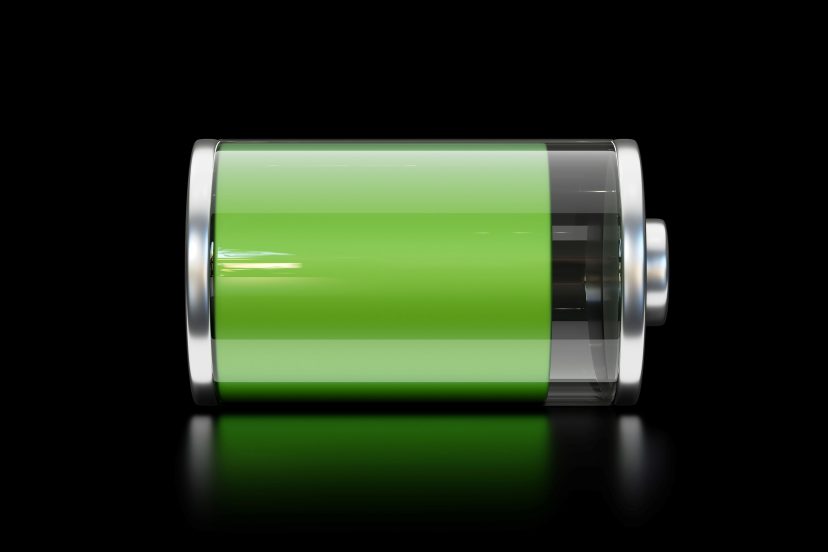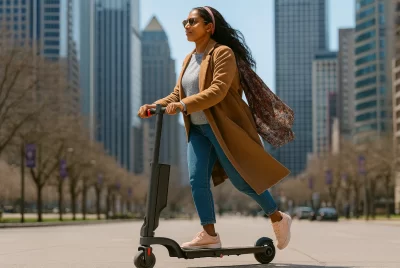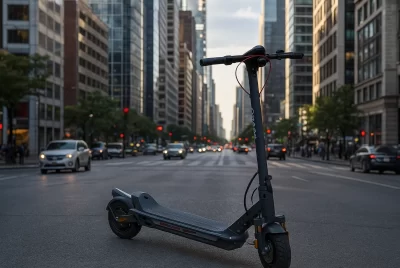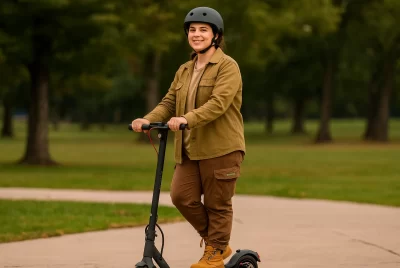Hoverboard Charger: Your Ultimate Guide
*We may earn a commission for purchases made using our links. Please see our disclosure to learn more.
Introduction to Hoverboards
I remember the first time I set foot on a hoverboard. The exhilaration, the fun, the sense of floating – it was like nothing I had ever experienced before. If you’re reading this, I’m willing to bet that you feel the same way.
These self-balancing scooters have revolutionized our perception of personal transportation, making it fun, convenient, and oh so exciting, always remember to keep your hoverboard charger not too far away so it doesn’t limit your distance.
The Importance of a Hoverboard Charger
But, just like every great superhero has their weakness, so do our beloved hoverboards. The kryptonite, in this case? The battery running out.
Hoverboards have undoubtedly changed the way we perceive personal transportation, making it not only fun but also eco-friendly and convenient. However, the thrill of gliding on a hoverboard comes to an abrupt halt when its battery reaches a low charge.
It’s a sinking feeling when you’re about to zip down the street, and the hoverboard refuses to power on, leaving you grounded and disconnected from that exciting floating sensation. This is where the unsung hero, the hoverboard charger, steps in.
The hoverboard charger is the life force behind these modern wonders, responsible for reviving their energy and granting them the power to take us on new adventures. It serves as a vital link between the hoverboard and a power source, allowing us to recharge the device and get back on our feet – or rather, wheels – in no time.
Understanding Your Hoverboard Charger
Voltage Requirements
When it comes to your hoverboard charger, understanding its voltage requirements is crucial. Each hoverboard model is designed to operate within specific voltage limits, typically ranging from 24V to 42V. This information can usually be found in the user manual or on the charger itself. Why is this important? Well, using the right voltage is essential for ensuring that your hoverboard charges correctly and, more importantly, safely.
If you use a charger with a voltage that is too low, it may not supply enough power to charge the hoverboard adequately. On the other hand, a charger with a voltage that is too high can overload the hoverboard’s battery and potentially cause damage or even safety hazards. Therefore, always double-check that you are using the correct charger with the appropriate voltage for your specific hoverboard model.
Charging Time
One of the key factors that hoverboard riders appreciate about their chargers is the relatively quick charging time. Most standard hoverboard chargers can fully power up a hoverboard within 2-3 hours.
However, it’s essential to note that the actual charging time can vary based on several factors, including the hoverboard’s battery capacity and the charger’s output capacity. High-capacity batteries will naturally take longer to charge, but they also tend to provide more extended riding times.
Conversely, hoverboards with smaller batteries might charge faster but offer a shorter riding duration. Understanding your hoverboard’s battery capacity and managing your charging habits accordingly can help you enjoy a seamless and uninterrupted riding experience.
Indicator Lights
Hoverboard chargers often come equipped with user-friendly indicator lights that provide valuable information about the charging process. These indicator lights are designed to keep you informed about the charging status, making the charging process simple and convenient.
When you connect your hoverboard to the charger and plug it into the power source, the indicator light will usually turn red, signaling that the charging process has started. As the battery charges and reaches its full capacity, the indicator light typically changes to green, indicating that your hoverboard is fully charged and ready for your next adventure.
These indicator lights act as visual cues, helping you to easily determine the charging status without the need to check your hoverboard or charger’s display. It’s a straightforward yet effective way to keep track of your hoverboard’s battery level and plan your rides accordingly.
Types of Hoverboard Chargers
Universal Chargers
The Bluetiango 42V 2A Replacement Charger is a UL Listed and certified power supply for 36V electric scooters and e-bikes. With an RCA 3-prong connector, it is compatible with brands like Gotrax, Swagtron, Brid, Segway, Ninebot, and Xiaomi. The charger ensures fast and smart charging for 36V lithium-ion batteries, featuring multiple safety protections. The green light indicates a full charge or disconnected status, and the package includes five items. After-sales support is available for prompt issue resolution.
- UL Listed & Certified: Approved by UL for quality and safety.
- Universal Compatibility: Suitable for 36V lithium-ion batteries in various electric scooters and e-bikes.
- Fast and Smart Charging: Quick charge with high current, green light indicates charge status.
- Not for All Battery Types: Specifically designed for 36V lithium-ion batteries, not compatible with lead-acid, 24V, 25.2V, and 29.4V versions.
- Limited Connector Type: Uses an RCA 3-prong connector, potentially limiting compatibility with devices requiring different connectors.
- Bulk Purchase: Comes in a package of five items, which may be excessive for individual users.
Imagine having one charger to rule them all – that’s the magic of universal chargers! These versatile chargers are designed to work with various hoverboard models, making them incredibly convenient for households with multiple hoverboards or for those who own different brands and models. Universal chargers typically come with interchangeable connectors or adjustable voltage settings, allowing them to adapt to different charging ports and voltage requirements.
The beauty of universal chargers lies in their flexibility and ease of use. Instead of cluttering your space with multiple chargers for each hoverboard, a single universal charger can handle all your charging needs. This not only simplifies your charging setup but also saves you time and effort when it comes to keeping your hoverboards powered up and ready for action.
Specific Model Chargers
When precision and optimized charging are what you seek, specific model chargers step in to deliver. These chargers are tailor-made to work with a particular brand or model of hoverboard. Manufacturers design them to ensure the charger’s voltage output, and charging capacity align perfectly with the unique requirements of the designated hoverboard.
Using a specific model charger provides several advantages. Firstly, it guarantees the most efficient and safe charging process for your hoverboard. The charger is precisely calibrated to complement the battery’s characteristics, preventing overcharging or undercharging, which can lead to battery degradation over time. Secondly, it helps maintain your hoverboard’s warranty, as some manufacturers may require the use of their branded charger to validate warranty claims.
If you own a high-end hoverboard or a premium model with advanced battery technology, a specific model charger is an investment that can contribute to extending your hoverboard’s lifespan and ensuring optimal performance.
Fast Chargers
The Suptopone 29.4V 2A Battery Charger in sleek black is designed for electric scooters, providing a fast replacement for 25.2V Li-ion and 24V LiFePO4 battery packs. With an input voltage of AC 100-240V (50/60Hz) and an output of DC 29.4V 2A, it features three universal plugs: 5.5mm 1 prong, 8mm 3 prong, and 12mm 3 prong connectors. This smart charger incorporates multiple protections to safeguard your battery, extending its cycle life. Easy to use with an LED indicator, the red light indicates charging, turning green when the battery is fully charged.
- Universal Compatibility: Designed for 25.2V Li-ion and 24V LiFePO4 batteries.
- Multiple Plugs: 5.5mm 1 prong, 8mm, and 12mm 3 prong connectors for versatility.
- Safe and Smart Charging: Ensures battery safety and longevity.
- Voltage and Connector Check: Users should verify battery voltage and connectors before purchase.
- Specific Battery Types: Tailored for 25.2V and 24V Li-ion and LiFePO4 batteries only.
- Caution for Bad Batteries: Not recommended for use with faulty batteries.
When time is of the essence, fast chargers become your best friends. These chargers are designed to juice up your hoverboard at a faster rate than standard chargers. If you’re in a hurry to get back on your hoverboard or if you have limited charging time available, a fast charger can save the day.
Fast chargers leverage advanced charging technology to deliver higher power output, effectively reducing the charging time required. While standard chargers may take 2-3 hours to fully charge a hoverboard, fast chargers can cut that time significantly, depending on the hoverboard model and the charger’s capabilities.
It’s essential to note that while fast chargers are convenient for quick top-ups, prolonged and frequent use of fast charging might impact the long-term health of your hoverboard’s battery. For regular charging sessions, it’s generally recommended to use standard chargers or follow the manufacturer’s guidelines for optimal battery care.
Choosing the Right Hoverboard Charger
When it comes to selecting the perfect hoverboard charger for your beloved self-balancing scooter, there are essential factors to consider to ensure a seamless and safe charging experience.
Compatibility
Above all else, compatibility is paramount. Before making any purchase, ensure that the charger you’re eyeing is fully compatible with your specific hoverboard model. Hoverboards come in various shapes and sizes, and each may have unique charging requirements. Using an incompatible charger can lead to ineffective charging or, worse, cause damage to the hoverboard’s battery and internal components.
To determine compatibility, check your hoverboard’s user manual or inspect the charging port to identify the voltage and current specifications required. Then, find a charger that precisely matches these requirements to guarantee optimal and safe charging.
Quality
The old adage “you get what you pay for” rings true when it comes to hoverboard chargers. Investing in a high-quality charger from a reputable brand is essential for several reasons.
First and foremost, a quality charger ensures safety during the charging process. Inferior chargers may lack the necessary safety mechanisms to prevent overcharging, short circuits, or overheating, potentially posing risks to both the hoverboard and the user.
Secondly, a well-made charger is more likely to have a durable design, capable of withstanding regular use and minimizing wear and tear. High-quality materials and craftsmanship contribute to a longer lifespan for the charger itself, ensuring it remains a reliable companion for your hoverboard rides.
Moreover, reputable brands often undergo rigorous testing and quality control measures to deliver a product that meets industry standards. Choosing a charger from a trusted manufacturer adds an extra layer of assurance that the charger is up to par with safety and performance requirements.
Price
While budget considerations are understandable, it’s crucial not to compromise on quality when choosing a hoverboard charger. Opting for a cheap, low-quality charger to save a few dollars might lead to more significant expenses in the long run.
As mentioned earlier, low-quality chargers may lack safety features, potentially leading to damage to your expensive hoverboard or even posing risks of fire or electrical hazards. Additionally, these chargers might not provide the optimal charging performance required to maintain your hoverboard’s battery health in the long term.
Instead, focus on finding a charger that strikes a balance between affordability and quality. Look for options from reputable brands that offer a combination of safety, performance, and value for money. It’s better to invest a little more upfront in a reliable charger that will protect your hoverboard and serve you well for an extended period.
Safety Precautions When Charging a Hoverboard
Hoverboards are undoubtedly fun and exciting, but when it comes to charging them, safety should be your top priority. There have been instances of fire and electrical faults caused by incorrect or irresponsible charging practices. To ensure a safe charging experience, follow these essential safety precautions:
- Charger Compatibility: Always use a charger that is specifically designed for your hoverboard model and matches its voltage and current requirements. Using an incompatible charger can lead to battery damage or even cause a fire hazard.
- Ventilation: While charging your hoverboard, place it in a well-ventilated area. Avoid charging the hoverboard on flammable surfaces or enclosed spaces, as lithium-ion batteries can generate heat during charging. Proper ventilation helps dissipate heat and reduces the risk of overheating.
- Avoid Overnight Charging: Never leave your hoverboard charging overnight or unattended. Overcharging can lead to battery degradation and potentially cause safety issues. Most modern chargers have auto-shutoff features that stop charging once the battery is fully charged, but it’s best not to take chances.
- Charging on Hard Surfaces: Charge your hoverboard on a flat, hard surface. Avoid charging on soft, combustible surfaces like carpets or beds, as they can obstruct airflow and trap heat.
- Regular Inspections: Periodically inspect the charging cable, connector, and charger itself for signs of damage or wear. If you notice any frayed wires or damage, discontinue using the charger and replace it immediately with a new, high-quality one.
Troubleshooting Common Hoverboard Charger Issues
- Overcharging: Overcharging is a common issue that can damage the hoverboard’s battery. To prevent this, use a charger with an auto-shutoff feature, which stops charging once the battery reaches its full capacity. Always unplug the charger once the charging is complete.
- Charger Not Working: If your charger doesn’t seem to work, start by checking the power outlet it’s connected to. Ensure the outlet is functional by plugging in another device. If the power outlet is working, and your charger still doesn’t function, it could indicate an issue with the charger itself or the hoverboard’s battery. In such cases, it’s best to seek professional assistance or contact the manufacturer for support.
- Battery Health: Keep an eye on your hoverboard’s battery health and performance. If you notice any significant decrease in battery life or charging time, it could indicate a problem with the battery or charger. Address such issues promptly to avoid potential safety hazards.
By adhering to these safety precautions and troubleshooting tips, you can enjoy your hoverboard with peace of mind, knowing that you are taking the necessary steps to keep yourself and your hoverboard safe during the charging process. Responsible charging practices not only protect your investment but also ensure that you can continue to experience the thrill and joy of riding your hoverboard safely for a long time.
Tips for Maintaining Your Hoverboard Charger
Taking good care of your hoverboard charger can go a long way in extending its lifespan and ensuring its continued performance.
Here are some essential tips for maintaining your charger:
- Proper Storage: When the charger is not in use, store it in a cool, dry place away from direct sunlight and moisture. Avoid exposing it to extreme temperatures, as this can affect its internal components.
- Gentle Handling: Handle the charger with care. Avoid yanking it out from the power outlet or the hoverboard. Instead, gently unplug the charger when it’s not in use or when the hoverboard is fully charged. Rough handling can cause damage to the charger’s connector or the charging port on the hoverboard.
- Keep It Clean: Dust and debris can accumulate on the charger’s connectors over time, affecting its performance. Regularly inspect the charger for any dirt or debris and gently clean it using a soft, dry cloth. Avoid using water or any liquids during cleaning to prevent damage to the charger.
- Avoid Overloading: Some chargers come with additional USB ports or outlets. Be cautious not to overload the charger by connecting multiple devices simultaneously, as this can lead to overheating and reduced charging efficiency.
- Check Cables: Inspect the charger’s cables periodically for any signs of wear, fraying, or damage. If you notice any issues with the cables, discontinue using the charger and replace it with a new one to avoid potential hazards.
Where to Buy a Hoverboard Charger
When it comes to purchasing a hoverboard charger, choosing a reliable source is crucial to ensure authenticity and quality.
Here are some options where you can buy a hoverboard charger:
- Online Platforms: Various online marketplaces, such as Amazon, eBay, or specialized hoverboard retailers, offer a wide range of hoverboard chargers. Read customer reviews and product descriptions to ensure you’re getting a charger that meets your hoverboard’s requirements.
- Electronics Stores: Local electronics stores or specialty stores that sell hoverboards often carry compatible chargers. Visiting a physical store allows you to examine the charger in person and seek advice from store representatives.
- Manufacturer Directly: Contacting the hoverboard manufacturer directly is another reliable option. Many manufacturers have official websites or customer support channels where you can purchase original replacement chargers designed specifically for your hoverboard model.
When purchasing a hoverboard charger, double-check the compatibility with your hoverboard model and make sure to buy from a reputable seller or directly from the manufacturer. By doing so, you can be confident that you’re acquiring a high-quality charger that will keep your hoverboard powered and ready for endless adventures.
Conclusion
In the world of hoverboards, the charger might not be the star of the show, but it certainly plays a vital role. As you’ve explored the various aspects of hoverboard chargers, it becomes evident that this unassuming device is one of the most critical components of your hoverboard setup.
A well-chosen hoverboard charger ensures that your rides are smooth, exhilarating, and free of interruptions. It keeps your hoverboard’s battery healthy, allowing you to experience that floating sensation and the thrill of gliding effortlessly. More importantly, a reliable charger safeguards both you and your hoverboard from potential hazards, making safety a top priority.
Remember to prioritize compatibility when selecting a charger, ensuring it perfectly matches your hoverboard’s voltage requirements. Opt for quality over cheap alternatives, investing in a charger from a reputable brand to guarantee optimal performance and safety. And as with any electronic device, proper maintenance goes a long way in extending the charger’s life and performance.
While the charger might not be the star attraction, it is undoubtedly the unsung hero that keeps your hoverboard adventure rolling. So, the next time you gear up for an electrifying ride on your hoverboard, take a moment to appreciate the role of the charger, silently working behind the scenes to power your joyrides and keep you safe. With a well-maintained charger in hand, you can embark on countless hoverboard adventures, confident that you have the energy to soar and explore the world from a whole new perspective.
FAQs
Can I use any charger for my hoverboard?
No, not all chargers are compatible with all hoverboards. It’s crucial to check the charger’s compatibility with your specific hoverboard model before purchasing. Using an incompatible charger can lead to ineffective charging or potential damage to the hoverboard’s battery and internal components.
How long does it take to charge a hoverboard?
The charging time for a hoverboard typically ranges from 2 to 3 hours. However, the exact duration can vary depending on factors such as the charger’s output capacity, the hoverboard’s battery capacity, and its current charge level. Most modern chargers come with auto-shutoff features that stop charging once the battery reaches full capacity, preventing overcharging.
Is it safe to leave my hoverboard charging overnight?
No, it is not recommended to leave your hoverboard charging overnight. While modern chargers are designed to have safety features, leaving the hoverboard charging unattended for an extended period can lead to overcharging, which may harm the battery and potentially cause safety issues. To ensure safety, always unplug the charger once the hoverboard is fully charged.
What does it mean when my charger light is blinking?
A blinking charger light can indicate various issues. It might suggest a problem with the charger itself, such as a loose connection or a faulty component. It could also signal an issue with the hoverboard’s battery. If you encounter this issue, it’s best to refer to the user manual for troubleshooting steps or contact the manufacturer for support and guidance.
Can I use a fast charger for my hoverboard?
Yes, you can use a fast charger for your hoverboard, but it’s essential to ensure compatibility. Some hoverboard models can handle fast charging, while others may not be designed to withstand the increased power output. Using a fast charger on an incompatible hoverboard might lead to battery damage or reduced battery life over time. If you choose to use a fast charger, it’s recommended to use it occasionally and not as the primary charging method to maintain the battery’s longevity.










